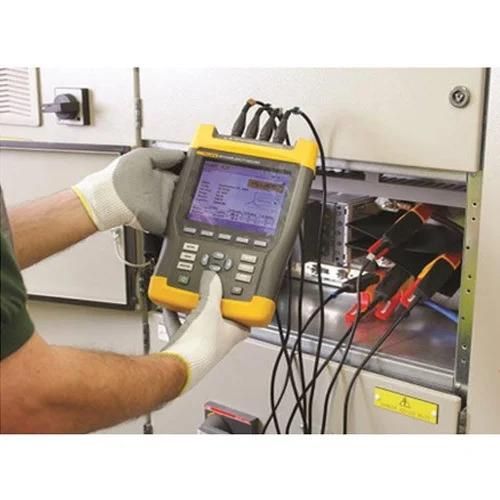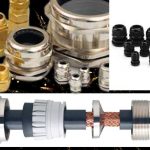What are power quality studies?
An electric power quality study is a systematic analysis to identify power quality issues, look for the base causes, and tips for improvement in an electrical system. Those issues are surges, harmonics, high-frequency noise, transient voltage, wave distortion, interruptions, frequency variations, etc. Power quality studies are also meant to be a focused and systematic approach to solving complex problems in a power system. Power qualities analysis is for new buildings and for existing plants. All must make electric network and loads operation run smoothly and more efficiently.
Types of Power Quality Interruption
Electrical equipment is sometimes exposed to transient overvoltage (surges/spikes), swells, flickers, unregulated voltages, voltage dips/sags, interruptions, or waveform disturbances (power factor, harmonics, others).
Overvoltage: –
Overvoltage happens in circumstances where the voltage exceeds its designed limit. Overvoltage can be induced by the disconnection of heavy loads (interruption of production processes in industries: decreasing speed of electric motors, arc furnaces, rolling mills, etc.) or by natural events such as lightning strikes. Spikes and transients differ from power surges because they are larger in magnitude yet much shorter in duration. This sudden loss of energy can result in circuit board or processor damage, memory loss, and data corruption.
Causes of overvoltage:
- Lightning
- Switching of lines
- ON/OFF power factor correction capacitors
- Disconnection of large loads
Consequences of overvoltage:
- Destruction of components (particularly electronic components)
- Insulation materials
- Data processing errors or data loss,
- Electromagnetic interference.

Figure 1
Voltage Swells / Surges: –
Momentary increase of the voltage, at the power frequency, outside the normal tolerances, with a duration of more than one cycle and typically less than a few seconds. Check out our complete range of surge protection devices to protect your application from the main supply service entrance until the end-load point of connection. SPDs are designed to prevent surges and transients.
Causes of swells:
- ON/OFF heavy loads
- Badly rated power sources
- Badly regulated transformers (mainly during off-peak hours).
Consequences of swells:
- Data loss
- The flickering of lighting and screens,
- The stoppage, or damage of sensitive equipment

Figure 2
Voltage Spikes & Transients:-
Spikes and transients are fast-moving, high-power bursts lasting for only a few milliseconds which might be imposed onto the regular mains strength supply. They range from a few volts to several thousand volts (some can be 6 kV or higher) and are caused by the sudden release of stored energy. Spikes and transients commonly occur during electrical storms and following lightning strikes.

Figure 3
Voltage Sag: –
A voltage sag is a short duration (i.e., 0.5 – 60 cycles) decrease in the RMS voltage magnitude, usually caused by a fault somewhere in the power system. Voltage sags are the most important power quality issue facing many industrial consumers. A sag is when the voltage drops below 90% of the nominal.
Causes:
- Faults in the transmission or distribution network (most of the time on parallel feeders).
- Faults in customer’s installation.
- Connection of big loads and start-up of large motors
- Switching OFF a huge reactive power source
- Operations of surge protector in the power system
Consequences:
The malfunction of equipment used in modern industrial plants (process controllers, PLC, Variable Speed Drives) is becoming more sensitive to voltage sags as the complexity of the equipment increases.
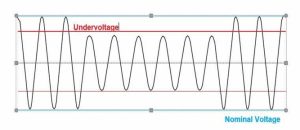 Figure 4
Figure 4
Flicker Effect: –
The flicker effect is a flickering of lights induced by fast variations in voltage. These voltage variations are caused by loads in which the power absorption varies very quickly: arc furnaces, welding machines, rolling machines, and laser cutters.
Consequences:
- Flicker impacts the safety of workspace and productivity, the comfort of living spaces, and, according to recent research, our overall health and emotional well-being.
- From a technological point of view, flicker strongly impacts lighting for digital image capture, particularly in TV studios and stadiums.
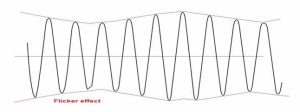 Figure 5
Figure 5
Harmonic Distortion: –
Devices that generate harmonics are present in the industrial sector, the service sector, and the home. Harmonics are generated by non-linear loads: nonlinear load is defined as when the current which flows through it does not have the same form or characteristics as the voltage that supplies it. Power electronics such as rectifiers, inverters, electronic starters, variable frequency motor drives, switching power supplies, and discharge lamps are classic examples of non-linear loads. The powering of non-linear loads causes the occurrence of THDIs (Total Harmonic Distortion Currents) circulating in the system. In turn, harmonic currents that flow through the power supply circuit (lines and transformers), cause the distortion of the mains voltage: the harmonic distortion in voltage THDU (Total Harmonic Distortion Voltage).
Consequences:
- The electronic power regulation systems may be disturbed by the fact of having to work with voltages that are not perfectly sinusoidal.
- Electronic signal systems, designed to work with very low currents, can easily be ignored by the presence of disturbances induced by high-frequency electromagnetic fields.
- Increased probability of the occurrence of resonance.
- Neutral Overload in 3-phase systems.
- Overheating of all cables and equipment and loss of efficiency in electric machines.
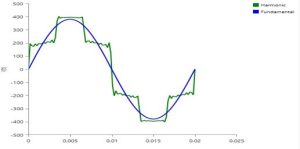 Figure 6
Figure 6
Low Power Factor: –
It’s not a power quality issue but it affects the efficiency of your electrical system and power bill.
A poor power factor (0.95 PF or less) is caused when a high level of inductive loads is connected to the circuit (electric motors, lighting ballasts, transformers) causing the voltage and current waveforms of the circuit to be out of phase and the resultant using more apparent power than is needed.
Why power quality study is important?
Power quality has a large impact on the performance and cost of a power system. Therefore, it is necessary to make sure that the power consumed by the system is of the right quality and that the system is compatible with the power delivered to it. Good power quality saves money and energy. Direct savings to consumers come from lower energy costs and reactive power tariffs. Indirect savings are gained by avoiding circumstances such as damage and premature aging of equipment, loss of production, or loss of data and work. Power quality can affect the overall company performance, which is a fact easily unnoticed by the management.
For more information and inquiries feel free to contact akshay@iengaust.com.au
You can also visit our official website- https://ieng.tech/power-system-studies-design/
#powerqualitys #harmonics #flicker #powerstudies


